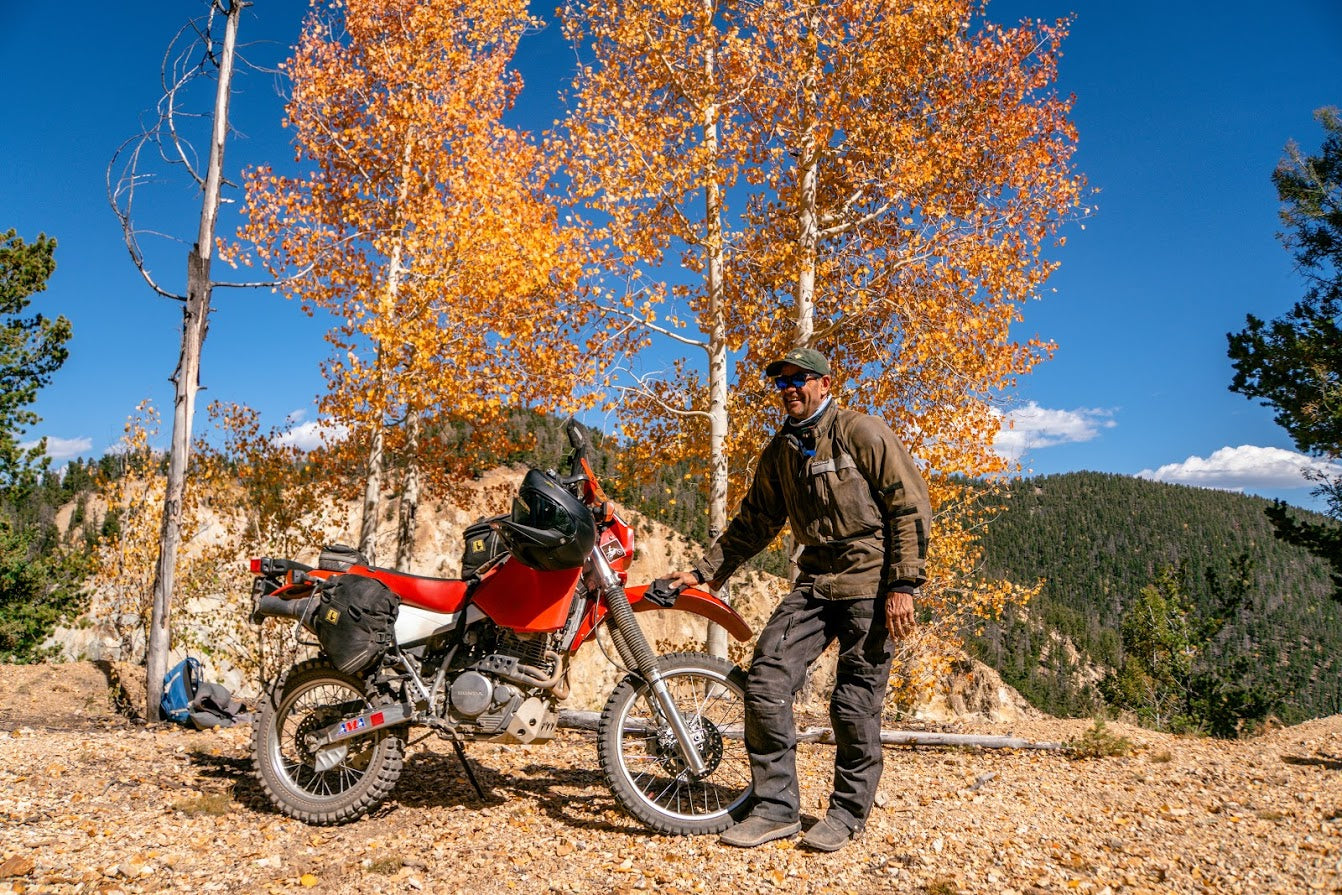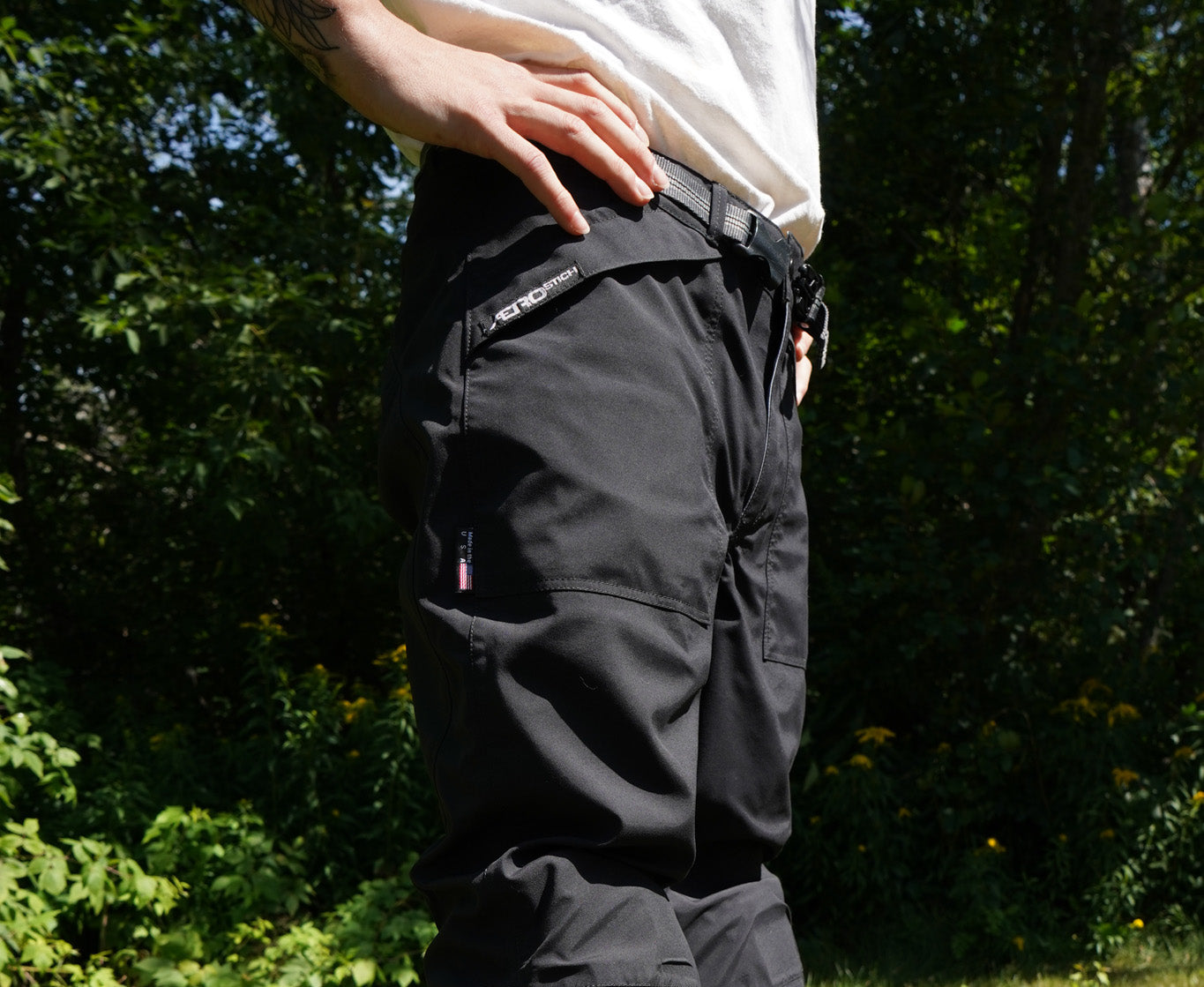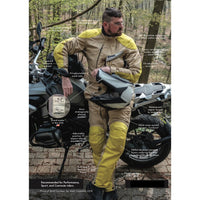Rightly or wrongly I’ve sometimes privately felt a bit like the legendary Johnny Appleseed, in that the purpose of my life’s work turned out to be to help make ordinary useful A to B daily motorcycle and scooter use in wealthy countries a bit safer, easier, more comfortable, and more popular.
By one rider at a time.
This wasn’t planned.
Making Aerostich one-piece coveralls is why the Aero Design & Manufacturing Company (inc.) was started. I simply wanted one of these coveralls for myself so day-to-day I could ride more and drive less. So I could ride on days when the weather was less-than-perfect. The weather is perfect for riding here about 5% of the time. The rest of the time it is either too hot, cold, windy, or wet. I wanted to ride anyway.
In this regard, and for some Aerostich suit purchasers, the one-piece suit has been somewhat subversive equipment. A rider may have bought it for a recreational ride to a distant motorcycle rally or some other bucket list destination, but after getting back home there it still is, still hanging in the garage or closet, softly calling the rider’s name like the Tell-Tale Heart in Edgar Allan Poe’s famous horror story. “Rider, rider” it whispers, using the rider’s name, “come out and play today…” followed by “It’s not too cold or windy or wet…” Only the owner of the coverall is able to hear the soft seductive voice saying over and over: “You can ride to work today…” Or to the grocery store, or to wherever. Over and over, it is saying: “Leave the car in the driveway today. Ride there…”
After hearing this sort of haunting invitation enough times, eventually one day the suit owner gives in and chooses the bike instead of the car. A few days pass, then a few weeks and eventually, they are choosing riding over driving a bit more often, somewhat to the concern of loved ones, employers, and (of course) the army of industrialists, governments and workers who create, provide and operate our complex car-centric surface transportation infrastructures. Including Elon, currently the grand hero-of-the-moment in these areas.
Forgive my small hubris comparing the work of Aerostich to the work of Johnny Appleseed. It’s just that those coverall suits do plant subtle seeds about the feasibility of everyday useful motorcycling into the hearts and minds of some riders who own and wear Roadcrafters, Classic Roadcrafters, R-3s, and Cousin Jeremy’s.
Until this morning I never knew anything about Mr. Appleseed beyond what has always floated around in popular culture. But today a fellow named William Ashworth, who writes and sends to a subscriber list an excellent daily email about a historical science figure (one per day), which I gratefully receive, made today’s post all about Johnny Appleseed, famous American 18th century amateur botanist.
Beyond planting a bunch of apple trees during his walkabout life, I never knew his actual story. This story may be of interest only to me (?) because of my experiences at Aerostich, but here it is anyway:
From: William Ashworth
Subject: Anniversary for Sep. 27, 2022: John Chapman (Johnny Appleseed)
Date: September 27, 2022 at 6:02:41 AM CDT
Bcc: agoldfine@aerostich.com
John Chapman, better known as Johnny Appleseed, nurseryman extraordinaire, was born Sep. 26, 1774, in Massachusetts (see first woodcut portrait of 1871). It is hard to sort through the legend of Johnny Appleseed to find the real John Chapman, but several historians have recently managed to make credible attempts. Chapman was a real enough figure, an itinerant who moved west to Pennsylvania, then Ohio, and finally Indiana, acquiring plots of land here and there, where he would plant orchards of apple trees from seed, and sell the sprouts for a penny or two apiece, which is where he got the money to buy land. He lived simply, wore second-hand clothes, disdained shoes, and slept on the ground except in extreme weather, when he had no problem finding a floor by a hearth, since he was a well-loved figure among the settlers. Here is a second portrait, from a different source, 1862.
In addition to sowing apples, Chapman spread the Gospel as he went, as taught by a Christian sect known as Swedenborgians, or the New Church, which seems to have emphasized the oneness of humans with nature. I do not know much about the Swedenborgians, but I do know a little about Jainism, and Chapman sounds like a Jain to me, although a Christian version. He respected all forms of animal and plant life, refusing to kill anything, even insects. Most apple trees were the result of grafting onto a rootstock, but Chapman refused to cut and wound a tree, and so he grew his trees from seeds. It has however been pointed out, cynically perhaps, that grafting is difficult and time-consuming, whereas it is fairly easy to haul around a gunnysack filled with seeds, which could be acquired free at cider mills. Here is a third woodcut, from the 1871 source.
The problem with growing apple trees from seed is that, if you plant the seeds from, say, a MacIntosh apple, you do not get a tree that bears MacIntosh apples. The seeds are unrelated to the apple the contains them. So the apples from Chapman’s trees were generally small and bitter. The fact that they were probably not too tasty may not have put a crimp in Chapman’s business, for the buyers of his two-penny sprigs were unlikely to know what kind of fruit they would bear until after Chapman had moved on. And they probably would not have cared, for the fact is that the reason people wanted apples was not to make America's favorite dessert, but rather to turn them into hard alcoholic cider. In hindsight, we know that Chapman’s habit of growing apples from seed was an ecological godsend, since he managed to leave behind an incredible variety of apple trees and thus inadvertently preserved most of the diversity inherent in the apple genome.
How Chapman morphed into the legendary Johnny Appleseed, who wore a pot for a hat and could communicate with animals, is not altogether clear. The mythical Appleseed probably blossomed from an article in 'Harper's New Monthly Magazine' in 1871, 26 years after his death. The article plays up his simple life, his missionary ways, and his reverence for animals. Recent scholarship has shown that Chapman may have led a simple life, but he was far from simple-minded, being a fairly shrewd and eventually wealthy businessman, who had accumulated quite a bit of valuable acreage and capital by the time of his death.
There are only two sets of near contemporary images of John Chapman, and both are posthumous. One is a single woodcut portrait that appeared in an 1862 history of Ashland County, Ohio, which I have no access to, but which is reproduced on Wikipedia, from which we borrow it (our second link). An account of Chapman in this book is one of the sources for his tin-pot hat. The other visual record is a set of three woodcuts that were included in the 'Harper’s New Monthly' article of 1871. For want of any other visual aids, I include all three here (our first, third, and fourth links), from a copy at Harvard. The last of the Harper’s woodcuts illustrates a story of an itinerant preacher, railing against modern decadence, who cried out, “Show me a primitive Christian,” whereby Chapman stepped forward in response..
Of course, if you prefer a pot-for-a-hat version of Chapman, you have your choice of dozens of covers from a variety of modern children’s editions of the Johnny Appleseed story. Here is a link to one, and to a second, with a young Johnny Appleseed and a child-sized pot.
Bill Ashworth
Should you want more of my drivel on the origin of the Aerostich suit, please follow this link to a much longer and fairly convoluted story explaining why (but not how) Aerostich suits came into existence. I didn’t have the courage to publish it on this blog without some kind of explanation like this.






















Hello,
This is an excellent read about Johnny Appleseed. Thank you for sharing, especially in regards to William Ashworth. I’m curious to know if you have a link to sign up to William’s subscriber list. I’d love to receive the same daily emails about historical science figures.
Thanks & regards,
Nate
Leave a comment